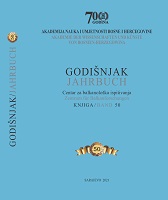Archaeological and Bioarchaeological Evidence from the Ottoman period Bosnia: The Case Study of Doboj-Čaršija
Archaeological and Bioarchaeological Evidence from the Ottoman period Bosnia: The Case Study of Doboj-Čaršija
Author(s): Aleksandar Jašarević, Jelena Bulatović, Jelena JovanovićSubject(s): Archaeology, 16th Century, 19th Century, The Ottoman Empire
Published by: Akademija Nauka i Umjetnosti Bosne i Hercegovine
Keywords: Ottoman period archaeology; Selimiye Mosque; Doboj; Bosnia; Zooarchaeology; Physical Anthropology;
Summary/Abstract: The Selimiye is a mosque complex located in the old city’s center of Doboj – the Upper Town (čaršija). We present the results of the first interdisciplinary analysis of archaeological and bioarchaeological finds from its excavations in 1994 attempting to get the first insights into living conditions of the Ottoman period Bosnia. Archaeological assemblage dated to the 16th-19th century is composed of pottery, clay tobacco pipes, small everyday metal objects, functional parts of costume, and glass fragments. Animal remains were probably associated with ritual context of food consumption during the Eid al-Adha feasts. Burial of a child inside the mosque’s harem indicates its belonging to an upper class Muslim family of Doboj.
Journal: Godišnjak Centra za balkanološka ispitivanja
- Issue Year: 2021
- Issue No: 50
- Page Range: 159-186
- Page Count: 28
- Language: English

